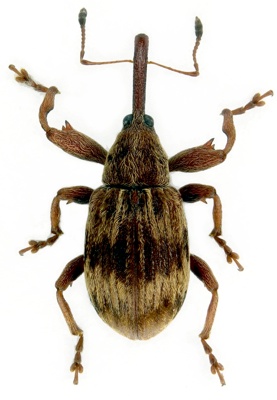Pests
Furcipus rectirostris (L.) - Cherry Weevil.
Systematic position.
Class Insecta, order Coleoptera, family Curculionidae, genus Furcipus Desbrochers. The genus easily differs from Anthonomus in double tooth on the fore femora.Synonyms.
Curculio druparum L.; Curculio tesselatus Geoffroy; Anthonomus rectirostris var. unicolor Faust; Anthonomus rectirostris var. padi Puton; Furcipes rectirostris var. interruptus Pic.Biological group.
The pests of stone-fruits (Cerasus fruticosa, C. vulgaris, Padus avium, Sorbus sp.).Morphology and biology.
Body without head, 3.0-5.0 mm in length. Body is yellow-brownish to brown-reddish in color, covered with dense pubescence consisting of yellow-brownish hairs. Elytra with 2 light and wide transversal bands in basal part and after midlength. Rostrum long, nearly straight and parallel-sided; male rostrum 1.4 times, female 1.6 times longer than head combined with pronotum. Antenna 7-segmented, inserted at preapical third of the rostrum. Eyes strongly convex. Pronotum 1.2 times as wide as long. Scutellum large. Elytra widest at preapical one third, their length 1.5 times as long as wide. Fore femora broader than mid and hind ones, with large double tooth. Proximal denticle on the tooth larger than distal one. The tooth on middle and hind femora smaller. Tarsal claw with long denticle. Adults fly very well. Larva white in color, slightly curved; pupa white-yellowish.Distribution.
Inhabits most part of Palearctic Region. In the former USSR, it is widely distributed from Krasnodar Territory in the south northward to Karelia, and from western state border eastward to the Far East.Ecology.
Everywhere monovoltine. Adults appear as a rule in the beginning of May, during breaking of buds on bird cherry trees. They occur after heating soil surface to temperature of about 9oC. Adult gnaws irregular-shaped holes on leaves, gnaws leaf stalks, and gnaws deep cavities on the apical sprouts. Female lays eggs one by one inside immature soft stone and close the pit aperture by frass. Mass oviposition occurs in the beginning of June. Eggs oval, white in color, their length reaches 0.7 mm. Egg development lasts 8-10 days; larva devours seed and pupates inside the pit. Mass pupation occurs in the 2nd half of July. The first adults emerge in the beginning of August. Adult increases diameter of the aperture before going out of the stone-fruit, feeding during this time on juice and pulp of the fruit. Adults do not feed after going out and leave to hibernate. They hibernate under the bark of trees, inside litter and in the surface layer of soil.Economic significance.
The pest damages bird cherry tree and mountain ash (Sorbus sp.) in the larval and imago stages. Sporadically, it harms cherry. In Ob River region, it destroys about 50% of the harvest of Sorbus aucuparia and 17% of that of Aronia melanocarpa. In Altai Territory, it feeds mainly on bird-cherry trees. The Cherry Weevil damages cherry plantations in the forest-steppe zone of Ukraine and Altai. In case of mass pest abundance, control measures in cherry plantations include treatments by insecticides in bud blossoming stage and right after full blossoming.Reference citations.
Arzanov Yu.G. 1989. Ecological and faunistic review of the weevil (Coleoptera, Curculionidae) from the steppe and desert zones of Rostov Region and Kalmykia. PhD Thesis. Leningrad: ZIN RAS, 24 p. (in Russian).Babenko Z.S. 1982. Phytophagous insects of fruit and berry plants in forest zone of Ob River Region. Tomsk: Tomsk University, 268 p. (in Russian).
Baitenov M.S. 1974. The weevils (Coleoptera: Attelabidae, Curculionidae) of the Middle Asia and Kazakhstan. Alma-Ata: Nauka, 286 p. (in Russian).
Dmitrieva I.N. 2005. Fauna and ecological peculiarities of the Curculionoidea (Coleoptera) in the North of forest-steppe zone of the Volga Region hills. Monograph. Cheboksary: Nizhnii Novgorod University, 180 p. (in Russian).
Dieckmann L. 1968. Revision der westpalaearktischen Anthonomini (Coleoptera, Curculionidae) [Revision of west palearctic Anthonomini (Coleoptera, Curculionidae)]. Beitrage Entomolgie, Berlin 17 (3/4): 377-564 (in German).
Ioannisiani T.G. 1972. The weevils (Coleoptera, Curculionidae) of Byelorussia. Minsk: Nauka i Tekhnika, 352 p. (in Russian).
Isaev A.Yu. 1994. Ecological and faunistic review of the weevils (Coleoptera: Apionidae, Rhynchophoridae, Curculionidae) of the Ulyanovsk Region. Ulyanovsk: Branch of the Moscow University, 77 p. (in Russian).
Korotyaev A.B. 1977. Ecological and faunistic review of the weevils (Coleoptera, Curculionidae) from the NE of USSR. Entomol. Obozr. 56 (1): 60-70 (in Russian).
Prokof.ev M.A. 1987. Siberian orchards protection against pests. Moscow: Rossel.khozizdat, 239 p. (in Russian).
Silfverberg, H. 1992. Enumeratio Coleopterorum Fennoscandiae, Daniae et Baltiae. Helsinki-Helsingfors: Helsingin Hyonteisvaihtoyhdistys, 94 p.
Ter-Minasyan M.E. 1936. Review of weevils from Anthonomus Germ. and Furcipus Desbr. genera (Coleoptera, Curculionidae) of the fauna of the USSR. In: Kuznetsov N.Ya., ed. Proceedings of Zoological Institute AS USSR. Moscow-Leningrad: AS USSR. V. 3: 165-182 (in Russian).
Vasil.ev V.P. & Livshits I.Z., 1958. The pests of the fruit crops. Moscow: Gosizd. Sel.khoz. lit. 392 p. (in Russian).


